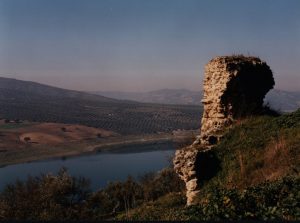Turrush castle is located on the top of a hill on the banks of the lznájar reservoir and close to the Fuentes de Cesna village.
The current vestiges of the Turrush fortress were erected in the Caliphate period, however, it seems to have an earlier origin located in the Visigothic period. The fort must have belonged to Count Artobás, grandson of King Witiza and a collaborator with the Arab invader, to whom he would later deliver the castle.
In this same castle, after the fall of the Visigothic kingdom, Abd al-Rahmán 1 sought refuge, after disembarking as a fugitive on the Granada beaches of Almuñécar. The choice of the Turrush castle was not random, on the contrary, it was one of the safest fortresses due to its remote and impregnable location in the rugged lands of western Granada. It is known that he remained in the fortress throughout the winter, dedicated to recruiting troops and winning followers for his cause. It is also known that he was visited by some emissaries of his enemy Yusuf al-Fihri, then emir of al Andalus, with a pact proposal that the Umayyad rejected, thus beginning the open confrontation between the two that would end with the victory of Abd al- Rahman. Thus, in 756, the Umayyad prince of Damascus would be proclaimed the first independent emir of al-Andalus.
The castle of Turrush housed under its protection a peasant community of autochthonous settlers, Mozarabic Christians who, although at first they welcomed the new Arab owners and the visit of the Umayyad prince, ended up rebelling against their authority. They refused to recognize the Cordovan state and to pay some taxes that they considered abusive. The Mozarabs, led by Omar ibn Hafsún, resisted in the castle of Turrush until Abd al-Rahmán 111 decided, in the year 921, to personally lead a contest to take the fortress. It took him 79 days to take the square, after a long siege in which communications from the castle were cut, razing fields and fruit trees. After Caliph Abd al-Rahmán’s victory over the Mozarabs in 111, the castle of Turrush was destroyed. It is probable that its primitive Christian population, who lived in the enclosure of about 2,750 m2. was forced to leave the place to establish a strong garrison and a population more loyal to the Umayyad dynasty. This fortress was known as Yuz’ Turrus, the term yuz’ meaning the district or territory of intensive agriculture related to the castle-fortress or hisn.
Turrush Castle re-enters the scene in later years as it is located in a border area. Once again it was reinforced and expanded in the 15th and 16th centuries by Nasrid engineers to regain strategic importance. It is located, unlike most towers and castles, in a valley: in the valley of the Pesquera river that acts as a communication route between the cities of Loja and Priego de Córdoba, between eastern Andalusia and the Guadalquivir valley. Finally, the Turrush tower is destroyed in the year 1431 by Álvaro de Luna.
This small fortress would still experience a new historical episode during the clashes between Castile and the Kingdom of Granada, as it would be the place where Boabdil was captured in the Battle of Lucena in 1483.
The fortress has a roughly square plan. The layout of the factory suggests a Caliphate castle built on the ground floor of a previous Byzantine-style castle. It is currently possible to observe the perimeter of the fortress, with four corners flanked by four square towers about five meters high, of which only two of them are well preserved, one built with concrete and the other with masonry. The material used is the rammed earth of stones and mortar with lime. It preserves several canvases of wall, about five meters high. Inside the fortified enclosure there are remains of tiles and glazed ceramics that, according to the latest archaeological studies, suggest the existence of a Mozarabic Christian settlement within the perimeter of the fortress. It has been declared an Asset of Cultural Interest.





